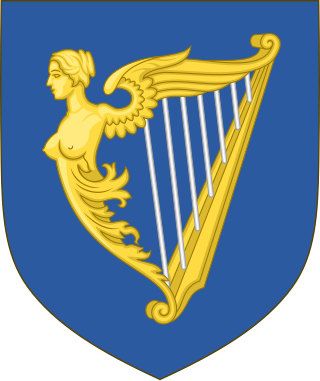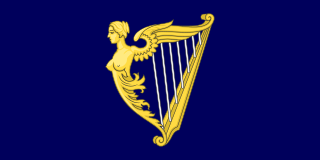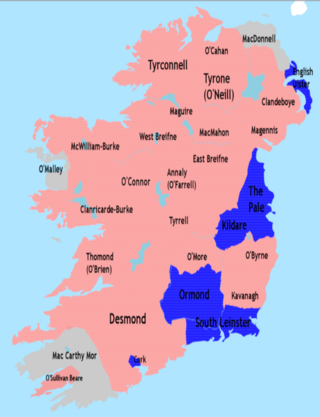Related Research Articles

The Irish House of Commons was the lower house of the Parliament of Ireland that existed from 1297 until the end of 1800. The upper house was the House of Lords. The membership of the House of Commons was directly elected, but on a highly restrictive franchise, similar to the unreformed House of Commons in contemporary Great Britain. Catholics were disqualified from sitting in the Irish parliament from 1691, even though they comprised the vast majority of the Irish population.

The Kingdom of Ireland was a dependent territory of England and then of Great Britain from 1542 to the end of 1800. It was ruled by the monarchs of England and then of Great Britain, and was administered from Dublin Castle by a viceroy appointed by the English king: the Lord Deputy of Ireland. Aside from brief periods, the state was dominated by the Protestant English minority. The Protestant Church of Ireland was the state church. The Parliament of Ireland was composed of Anglo-Irish nobles. From 1661, the administration controlled an Irish army. Although styled a kingdom, for most of its history it was, de facto, an English dependency. This status was enshrined in Poynings' Law and in the Declaratory Act of 1719.

Loyalism, in the United Kingdom, its overseas territories and its former colonies, refers to the allegiance to the British crown or the United Kingdom. In North America, the most common usage of the term refers to loyalty to the British Crown, notably with the loyalists opponents of the American Revolution, and United Empire Loyalists who moved to other colonies in British North America after the revolution.

Roger de Mortimer, 4th Earl of March, 6th Earl of Ulster was an English nobleman. He was considered the heir presumptive to King Richard II, his mother's first cousin, as being a great-grandson of King Edward III.

The Plantation of Ulster was the organised colonisation (plantation) of Ulster – a province of Ireland – by people from Great Britain during the reign of King James VI and I. Most of the settlers came from southern Scotland and northern England; their culture differed from that of the native Irish. Small privately funded plantations by wealthy landowners began in 1606, while the official plantation began in 1609. Most of the land had been confiscated from the native Gaelic chiefs, several of whom had fled Ireland for mainland Europe in 1607 following the Nine Years' War against English rule. The official plantation comprised an estimated half a million acres (2,000 km2) of arable land in counties Armagh, Cavan, Fermanagh, Tyrone, Donegal, and Londonderry. Land in counties Antrim, Down, and Monaghan was privately colonised with the king's support.

The Irish Rebellion of 1798 was a popular insurrection against the British Crown in what was then the separate, but subordinate, Kingdom of Ireland. The main organising force was the Society of United Irishmen. First formed in Belfast by Presbyterians opposed to the landed Anglican establishment, the Society, despairing of reform, sought to secure a republic through a revolutionary union with the country's Catholic majority. The grievances of a rack-rented tenantry drove recruitment.

The House of Burgh or Burke was an ancient Anglo-Norman and later Hiberno-Norman aristocratic dynasty which played a prominent role in the Norman invasion of Ireland, held the earldoms of Kent, Ulster, Clanricarde, and Mayo at various times, and provided queens consort of Scotland and Thomond and Kings of England via a matrilineal line.

The Irish Rebellion of 1641 was an uprising in Ireland, initiated on 23 October 1641 by Catholic gentry and military officers. Their demands included an end to anti-Catholic discrimination, greater Irish self-governance, and return of confiscated Catholic lands. Planned as a swift coup d'état to gain control of the Protestant-dominated central government, instead it led to the 1641–1653 Irish Confederate Wars, part of the wider Wars of the Three Kingdoms.

The Nine Years' War, sometimes called Tyrone's Rebellion, took place in Ireland from 1593 to 1603. It was fought between an Irish confederation—led mainly by Hugh O'Neill of Tyrone and Hugh Roe O'Donnell of Tyrconnell—against English rule in Ireland, and was a response to the ongoing Tudor conquest of Ireland. The war began in Ulster and northern Connacht, but eventually engulfed the entire island. The Irish alliance won numerous victories against the English forces in Ireland, such as the Battle of Clontibret (1595) and the Battle of the Yellow Ford (1598), but the English won a pivotal victory against the alliance and their Spanish allies in the siege of Kinsale (1601–02). The war ended with the Treaty of Mellifont (1603). Many of the defeated northern lords left Ireland to seek support for a new uprising in the Flight of the Earls (1607), never to return. This marked the end of Gaelic Ireland and created the groundwork for the foundation of the Plantation of Ulster.

The Tudor conquestof Ireland took place during the 16th century under the Tudor dynasty, which ruled the Kingdom of England. The Anglo-Normans had conquered swathes of Ireland in the late 12th century, bringing it under English rule. In the 14th century, the effective area of English rule shrank markedly, and from then most of Ireland was held by native Gaelic chiefdoms. Following a failed rebellion by the Earl of Kildare in the 1530s, the English Crown set about restoring its authority. Henry VIII of England was made "King of Ireland" by the Crown of Ireland Act 1542. The conquest involved assimilating the Gaelic nobility by way of "surrender and regrant"; the confiscation and colonisation ('plantation') of lands with settlers from Britain; imposing English law and language; banning Catholicism, dissolving the monasteries and making Anglican Protestantism the state religion.

Plantations in 16th- and 17th-century Ireland involved the confiscation of Irish-owned land by the English Crown and the colonisation of this land with settlers from Great Britain. The Crown saw the plantations as a means of controlling, anglicising and 'civilising' Gaelic Ireland. The main plantations took place from the 1550s to the 1620s, the biggest of which was the plantation of Ulster. The plantations led to the founding of many towns, massive demographic, cultural and economic changes, changes in land ownership and the landscape, and also to centuries of ethnic and sectarian conflict. They took place before and during the earliest English colonisation of the Americas, and a group known as the West Country Men were involved in both Irish and American colonization.
Scotch-IrishAmericans are American descendants of primarily Ulster Scots people who emigrated from Ulster to the United States during the 18th and 19th centuries. Their ancestors had originally migrated to Ulster, mainly from the Scottish Lowlands and Northern England in the 17th century. In the 2017 American Community Survey, 5.39 million reported Scottish ancestry, an additional 3 million identified more specifically with Scotch-Irish ancestry, and many people who claim "American ancestry" may actually be of Scotch-Irish ancestry.

In the history of colonialism, a plantation was a form of colonization in which settlers would establish permanent or semi-permanent colonial settlements in a new region. The term first appeared in the 1580s in the English language to describe the process of colonization before being also used to refer to a colony by the 1610s. By the 1710s, the word was also being used to describe large farms where cash crop goods were produced, typically in tropical regions.

Norroy and Ulster King of Arms is the provincial King of Arms at the College of Arms with jurisdiction over England north of the Trent and Northern Ireland. The two offices of Norroy and Ulster were formerly separate. Norroy King of Arms is the older office, there being a reference as early as 1276 to a "King of Heralds beyond the Trent in the North". The name Norroy is derived from the Old French nort roy meaning 'north king'. The office of Ulster Principal King of Arms for All-Ireland was established in 1552 by King Edward VI to replace the older post of Ireland King of Arms, which had lapsed in 1487.
Ulick Burke, 3rd Earl of Clanricarde, styled Lord Dunkellin until 1582, was an Irish peer who was the son of Richard Burke, 2nd Earl of Clanricarde and Margaret O'Brien.
Coleraine Castle was a castle situated at Coleraine, County Londonderry, Northern Ireland.
Events from the year 1605 in Ireland.
Events from the year 1577 in Ireland.

Kinelarty is a former Irish district and barony in County Down, Northern Ireland. It lies east of the centre of the county, and is bordered by five other baronies: Iveagh Upper, Lower Half to the west; Lecale Upper to the south and south-east; Lecale Lower to the east; Castlereagh Upper to the north; and Iveagh Lower, Upper Half to the north-west.

Irish Americans are ethnic Irish who live in the United States and are American citizens. Most Irish Americans of the 21st century are descendants of immigrants who moved to the United States in the mid-19th century because of the Great Famine in Ireland.
References
- ↑ Sean J. Connolly (1998). The Oxford companion to Irish history . Oxford University Press. p. 177 . Retrieved 25 February 2013.
- ↑ John Patrick Montaño (11 August 2011). The Roots of English Colonialism in Ireland. Cambridge University Press. p. 147. ISBN 978-0-521-19828-8 . Retrieved 25 February 2013.
- ↑ Commission, Irish Manuscripts (1992). Analecta Hibernica. p. 127. Retrieved 25 February 2013.
- ↑ Christine Kinealy (1 October 2008). A New History of Ireland. Sutton. p. 77. ISBN 978-0-7509-4816-6 . Retrieved 25 February 2013.
- ↑ Martin Marix Evans; David Lyons (October 2003). A terrible beauty. Gill & Macmillan. ISBN 9780717135424 . Retrieved 25 February 2013.
- ↑ Hiram Morgan (1 April 1999). Tyrone's Rebellion: The Outbreak of the Nine Years War in Tudor Ireland. Boydell & Brewer. p. 21. ISBN 978-0-85115-683-5 . Retrieved 25 February 2013.